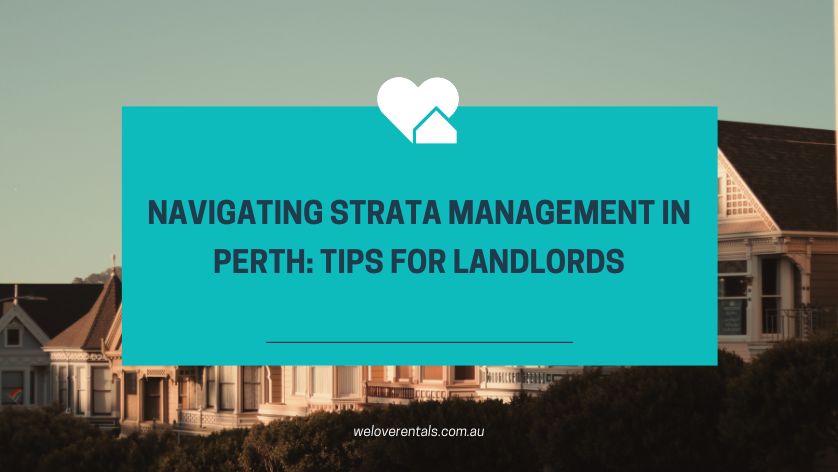
Navigating Perth Strata Management as a Landlord
Are you about to buy a strata property in Perth, but not sure you understand all of what’s involved?
Or perhaps you own strata property, and find managing it challenging?
Strata properties make great rentals but are more complicated to buy and manage than freehold houses. So, feeling daunted is understandable.
We can’t make you an expert overnight, but here are some of the answers, with reliable sources to learn more!

A Quick Overview of Strata
Before buying into strata, we recommend learning the basics of how it works.
A strata titles scheme is freehold land subdivided into:
- two or more lots or
- two or more lots, plus common property.
Each unit, duplex, townhouse, villa, or survey-strata block is a lot.
Common property is owned jointly by all the scheme’s lot owners.
A strata company, made up of all lot owners, exists for every strata scheme. It manages the scheme’s:
- common property
- financials
- insurance
- by-law* enforcement.
*Every strata scheme defaults to schedule 1 and 2 by-laws provided in S228 of the Strata Titles Act 1985, or adopts alternative by-laws agreed by owners.
In schemes larger than 3 lots, strata company duties are carried out by a council of lot owners.
In larger schemes, councils often employ a strata manager to act for them.
Types Of Strata
There are two main types of strata.
‘Built’ Strata
‘Built’ strata always has at least one building:
- each owner owns a ‘lot’ — e.g. a unit
- owners share ownership and responsibility for ‘common property’.
Lot boundaries are defined on the strata plan using building surfaces.
Boundaries are important, as they determine who pays for what, but can be confusing because they vary, and are interpreted from the strata plan.
An entire high-rise building can be common property — ‘lots’ are effectively the airspace inside each apartment. The strata company pays for all maintenance out of levies paid by all owners.
In single-tier schemes (no lots are above other lots), lot boundaries are often external surfaces of buildings. Individual owners own their structure and pay their own maintenance.
There can however be unusual variations on boundaries, for example lot owners owning their walls but not their roof.
It can pay to get expert help interpreting the strata plan!
Survey-Strata
In survey-strata schemes, lot boundaries are based on land, as shown on the survey-strata plan. Owners share ownership of ‘common property’ like driveways.
Owners own their own structures and share the costs of maintaining and insuring common property.
What’s Tricky About Investing in a Strata Property?
Most investors find buying and letting a house relatively straightforward.
As you can see, strata property is more involved.
Doing Your Due Diligence When Buying Strata Property
Strata sellers must give buyers detailed disclosure, including:
- scheme documents:
- strata plan
- by-laws
- unit entitlements*
- meeting minutes of last AGM
- statement of accounts
- termination proposals
- annual levies
- sellers debts to strata company
- lot details
- exclusive use by-laws.
*Unit entitlement: the comparative value of the lot compared with all other lots — this determines owner voting rights and levies.
NOTE: Levies are a major expense — find out what you’ll be up for!
By-laws matter — they determine what tenants can or can’t do.
Meeting minutes reveal past problems and future costs.
Landgate’s Buying and selling resource provides more detail on disclosures.
NOTE: To minimise risk, read disclosures. Consider seeking expert advice before signing contracts.
Skimping on due diligence can lead to disappointment. Buyers sometimes find out too late about ‘deal breakers’ — for example:
- areas they believed were within the lot are common property g. a lawn or carpark
- short-term letting is banned
- costly major works are pending.
This can cause major stress!
Buying Off-The-Plan
Buying strata off-the-plan carries additional risks.
Contracts are complex — buyers can miss crucial ‘fine print’ clauses that disadvantage them.
Some buyers find their contract allows developers to:
- revoke the contract
- demand a higher price
- cancel construction
- alter agreed fit-out / floor area.
Buying off-the-plan requires care and expert advice!
When Renting Out Strata Property
Here are two key things to consider when letting strata property.
Stakeholders
Many stakeholders can be involved — tenants, the strata company, strata council, and strata managers — this makes communications challenging.
If you’re new to buying/letting strata, an experienced property manager, familiar with strata processes, can help.
This Strata Community Association guide may help.
Responsibility For Tenants
When letting strata property, you’re responsible for tenants complying with by-laws.
Always let tenants know the rules. State in the lease that breaching by-laws breaches the lease.
- Disclose by-laws prior to tenants signing the lease.
- Never offer lease terms that conflict with by-laws, e.g. agreeing to unapproved pets.
Landgates’s Living in a scheme fact sheet provides more information.
What Should I Do Now?
Why not give us a call?
The experienced team at We Love Rentals deal with strata issues daily. They understand tenants, owners, and strata managers, and can also refer you to agents with extensive strata experience.
We’re happy to help!
Why not email us or call (08) 6254 6300 for friendly, professional advice.

